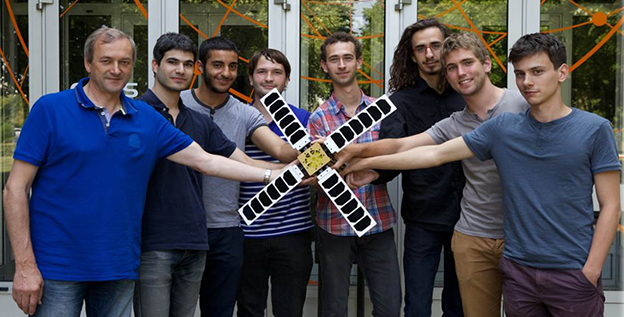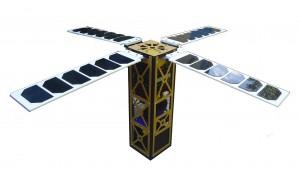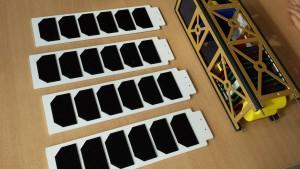CNES (the French National Center for Space Research) was responsible for the first spacecraft to orbit a comet, the Rosetta Project, and now Pascal Martinelli, who supervised the conception and manufacturing of that satellite, has helped a group of French students do their part to make a new aerospace project happen.
 The EyeSat mission is planned to place a satellite to observe the Milky Way, and it’s part of the larger Janus Project. A few times every year, the CNES launches missions which include the best engineering students from France.
The EyeSat mission is planned to place a satellite to observe the Milky Way, and it’s part of the larger Janus Project. A few times every year, the CNES launches missions which include the best engineering students from France.
“It’s a practical tool to get students at engineering schools and universities more involved in space sciences,” says Alain Gaboriaud, the project leader at CNES.
 In Rosetta, the European Space Agency’s (ESA) “comet chaser” project from back in 2004, the world saw the most detailed images of a comet ever taken. For the last ten years, the orbiter has floated through our solar system, across an asteroid belt and on into deep space. That collaboration with NASA saw it travel more than five times Earth’s distance from the Sun, and now the EyeSat Project is one of those collaborations with students and EAS.
In Rosetta, the European Space Agency’s (ESA) “comet chaser” project from back in 2004, the world saw the most detailed images of a comet ever taken. For the last ten years, the orbiter has floated through our solar system, across an asteroid belt and on into deep space. That collaboration with NASA saw it travel more than five times Earth’s distance from the Sun, and now the EyeSat Project is one of those collaborations with students and EAS.
In all, the EyeSat required nearly 400 3D printed parts throughout the 14 iterations of the prototyping process, and the CNES used Sculpteo’s 3D printing services to build those parts.
The project also made use of 3D printed parts for more than just the prototyping stage of the effort. The final version of the satellite included 3D printed components. The technology was used to print four mounting brackets and a sunvisor.
“3D printing is not necessarily the first manufacturing technique that comes to mind when you’re designing a satellite. Engineers are still lacking some experience with it and that’s one of the reasons why it’s not used as much as it should be to produce the final EYESAT satellite,” Martinelli says. “The other reason however is more down to earth. Polyamide even when not 3D printed can absorb 5% of its weight in water, which means water can get inside the material. While in space, any moisture would turn into condensation on the lenses of the camera resulting in degraded images. That’s why we still need to test 3D printed parts for this.”
 In 2013 alone, the JANUS project featured a dozen individual projects in development – and they all used 3D printing as a key part of the manufacturing process.
In 2013 alone, the JANUS project featured a dozen individual projects in development – and they all used 3D printing as a key part of the manufacturing process.
“For the manufacturing of models it would have been impossible to plan this series of 12 units for the deadlines granted to this operation,” said Martinelli. “The project are difficult to fund, and even if 3D printing isn’t economically efficient in every case, in this particular case, it was the only way to meet our budget.”
This project, a collaboration between student engineers and CNES, certainly saw a huge boost thanks to 3D printing. Do you know about any other aerospace projects which use 3D printing? Let us know in the EyeSat Project forum thread on 3DPB.com.
Subscribe to Our Email Newsletter
Stay up-to-date on all the latest news from the 3D printing industry and receive information and offers from third party vendors.
You May Also Like
3D Printing Financials: Fathom Struggles in Financial Quicksand During Critical Transition
Facing a year of key transitions and financial pressures, Fathom (Nasdaq: FTHM) has filed its annual report for 2023 with the U.S. Securities and Exchange Commission (SEC). The document outlines...
Latest Earnings Overview for Australian 3D Printing Firms Titomic and AML3D
Australian 3D printing manufacturing firms Titomic (ASX: TTT) and AML3D (ASX: AL3) reported their financial results for the period from July to December 2023, marking the first half of their...
3D Printing Webinar and Event Roundup: April 7, 2024
Webinars and events in the 3D printing industry are picking back up this week! Sea-Air-Space is coming to Maryland, and SAE International is sponsoring a 3D Systems webinar about 3D...
3D Printing Financials: Unpacking Farsoon and BLT’s 2023 Performance
In the Chinese 3D printing industry, two companies, Farsoon (SHA: 688433) and Bright Laser Technologies, or BLT (SHA: 688333), have recently unveiled their full-year earnings for 2023. Farsoon reported increases...































